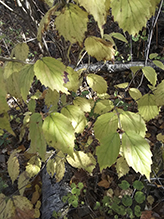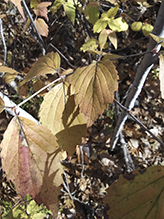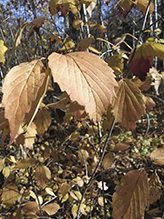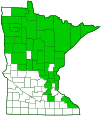downy arrowwood
(Viburnum rafinesqueanum var. rafinesqueanum)
Conservation • Description • Habitat • Ecology • Use • Distribution • Taxonomy
Conservation Status |
|
|||||||
| IUCN Red List | not listed |
|||||||
| NatureServe | N5 - Secure SNR - Unranked |
|||||||
| Minnesota | not listed |
|||||||
Description |
||
Downy arrowwood is a medium-sized shrub that rises on multiple stems from a woody, spreading root system. It occurs in North America east of the Great Plains from Quebec to Manitoba south to South Carolina and Tennessee. It is common in northern and eastern Minnesota, mostly absent in the southwestern quarter of the state. It grows in moderately moist to dry upland woodlands in full sun, partial sun, or deep shade. There are two varieties of downy arrowwood, rafinesqueanum and affine. The ranges of both varieties appear identical, and many collected specimens have intermediate characteristics. Nevertheless, the varieties are generally, though not universally, accepted. Both varieties occur in Minnesota. Downy arrowwood (var. rafinesqueanum) can be 3′ to 9′ tall and up to 1 3 ⁄16″ (3 cm) in diameter at the base, but in Minnesota it is usually no more than 6′ in height. The roots have buds which may sprout and form above-ground stems (suckers). When conditions permit, it forms colonies. The bark on the lower stem is gray and wrinkled, and it sometimes, though rarely, peels in papery sheets. On older stems it becomes gray or grayish-brown to reddish-brown and fissured. On the upper stem and branches the bark is gray or grayish-brown and smooth. Young twigs are green to reddish-green, round in cross section, and slightly hairy. They have widely scattered white pores (lenticels). When cut at a diagonal, the soft tissue visible in the center of the twig (pith) is solid. The twigs are brown to reddish-brown in their second year. The buds are egg-shaped to cone-shaped, slightly flattened, and hairless. They have two pairs of overlapping scales. They are not sticky or are only slightly sticky. The leaves are opposite, undivided (simple), and deciduous. They are attached to the twig on a short, light green to red leaf stalk (petiole). The petiole averages ¼″ (6 mm) long, about one-tenth as long as the blade, but can be ⅛″ to ⅝″ (3 to 15 mm) long. It is grooved on the upper (ventral) side, and is sparsely to moderately hairy, especially along the groove. It is not winged and there are no projecting glands near the attachment to the leaf blade. At the base of each petiole there is a pair of leaf-like appendages (stipules). The stipules are green to reddish-green, narrow with almost parallel sides (linear), and partially fused to the base of the petiole. They are ⅛″ to ⅜″ (3 to 9 mm) long, often longer than the petiole. The leaf blades are relatively thin and papery, egg-shaped to broadly lance egg-shaped, 1½″ to 4″ (4 to 10 cm) long, 1¼″ to 2¾″ (3 to 7 cm) wide. They are rounded or shallowly heart-shaped at the base and narrowly angled to a point at the tip with straight or concave sides along the tip. They are pinnately veined. The lateral veins are straight, evenly spaced, and end in a tooth at the margin. There are often 3 to 5 secondary veins near the base on each side. The upper surface is green and sometimes hairless but usually has scattered, unbranched hairs. The lower surface is pale green and is sparsely to moderately but uniformly covered with mostly unbranched hairs. There are usually small dense patches of woolly hairs in the angles (axils) of the main veins. The margins have usually 6 to 10 (rarely up to 14) coarse teeth on each side. The leaves turn an attractive dull purplish-red to dull purple with red highlights in the fall. The inflorescence is a dense, rounded, shallowly convex, ¾″ to 2⅜″ (2 to 6 cm) in diameter, branched cluster (cyme) of 30 to 100 flowers at the ends of the current-year branches. The cymes have 4 to 7 main branches. They may be almost stalkless or have inflorescence stalks (peduncles) up to 2⅜″ (6 cm) long. The flowers on the margin of the cyme are fertile and are similar in appearance and size to the interior flowers. Each flower is about ¼″ in diameter. There are five sepals, five petals, five stamens, and no style. The sepals are green, fused for most of their length into a minute cup (calyx), and separated at the tip into five minute, triangular lobes. The petals are creamy white, broadly egg-shaped to elliptical, and 1 ⁄16″ to ⅛″ (1.5 to 3.0 mm) long. The stamens have white filaments and tan anthers. They are 1 ⁄16″ to ⅛″ (1.5 to 4.0 mm) long and extend beyond the petals. There is a three-lobed, stalkless stigma on a short disk (stylopodium) at the top of the ovary. The flowers appear in late May to early July. They have a fragrance that may appeal to insects but does not to humans. The fruit is an edible, juicy, berry-like, oblong to ellipse-shaped or nearly spherical, somewhat flattened, ¼″ to ⅜″ (6 to 9 mm) long drupe. It is green initially, becoming bluish-purple to purplish-black at maturity. It is not covered with a whitish, waxy bloom (glaucous). The fruit contains a single ¼″ to 5 ⁄16″ (6 to 8 mm) stone. The stone is somewhat flattened and is shallowly grooved on both sides. The fruit ripens in early August to early September. |
||
Height |
||
3′ to 9′ |
||
Flower Color |
||
Creamy white |
||
Similar Species |
||
Habitat |
||
Moderately moist to dry. Woodlands. Full sun, partial sun, or deep shade. |
||
Ecology |
||
Flowering |
||
Late May to early July |
||
Pests and Diseases |
||
|
||
Use |
||
|
||
Distribution |
||||
|
Sources |
|||
| 10/26/2021 | ||||
Nativity |
||||
Native |
||||
Occurrence |
||||
Common |
||||
Taxonomy |
|||
| Kingdom | Plantae (Plants) | ||
| Subkingdom | Pteridobiotina | ||
| Phylum | Tracheophyta (Vascular Plants) | ||
| Class | Magnoliopsida (Dicots) | ||
Order |
Dipsacales (honeysuckles, moschatels, and allies) | ||
Family |
Viburnaceae (elder) | ||
Genus |
Viburnum (viburnums) | ||
| Species | Viburnum rafinesqueanum (downy arrowwood) | ||
Species Family Currently (2023), some sources, including USDA PLANTS and NatureServe, place the genera Sambucus and Viburnum in the Caprifoliaceae family. Some sources, including ITIS and NCBI, place them in the Adoxacea family. Almost all other sources, including APG IV, World Flora Online, Plants of the World Online, GRIN, GBIF, and iNaturalist, place the two genera in the Viburnaceae family. |
|||
Synonyms |
|||
Viburnum rafinesquianum var. rafinesquianum |
|||
Common Names |
|||
downy arrow-wood downy arrowwood downy-leaf arrow-wood Rafinesque’s arrowwood |
|||
Glossary
Axil
The upper angle where a branch, stem, leaf stalk, or vein diverges.
Calyx
The group of outer floral leaves (sepals) below the petals, occasionally forming a tube.
Cyme
A branched, flat-topped or convex flower cluster in which the terminal flower opens first and the outermost flowers open last.
Drupe
A fleshy fruit with a single hard, stone-like core, like a cherry or peach.
Glaucous
Pale green or bluish gray due to a whitish, powdery or waxy film, as on a plum or a grape.
Lenticel
A corky, round or stripe-like, usually raised, pore-like opening in bark that allows for gas exchange.
Linear
Long, straight, and narrow, with more or less parallel sides, like a blade of grass.
Peduncle
In angiosperms, the stalk of a single flower or a flower cluster; in club mosses, the stalk of a strobilus or a group of strobili.
Petiole
On plants: The stalk of a leaf blade or a compound leaf that attaches it to the stem. On ants and wasps: The constricted first one or two segments of the rear part of the body.
Pinnately veined
With the veins arranged like the vanes of a feather; a single prominent midvein extending from the base to the tip and lateral veins originating from several points on each side.
Pith
The spongy cells in the center of the stem.
Stigma
In plants, the portion of the female part of the flower that is receptive to pollen. In Lepidoptera, an area of specialized scent scales on the forewing of some skippers, hairstreaks, and moths. In Odonata, a thickened, dark or opaque cell near the tip of the wing on the leading edge.
Stipule
A small, leaf-like, scale-like, glandular, or rarely spiny appendage found at the base of a leaf stalk, usually occurring in pairs and usually dropping soon.
Sucker
A basal shoot rising from the roots or from a bud at the base of a shrub or tree.
Winged leaf stalk
A leaf stalk with a leaf-like or membrane-like extension along both sides.
Visitor Photos |
|||||
Share your photo of this plant. |
|||||
| This button not working for you? Simply email us at info@MinnesotaSeasons.com. Attach one or more photos and, if you like, a caption. |
|||||
Luciearl |
|||||
Downy Arrow-wood As the woods start to thin out on my trail at the end of the season, I started noticing this shrub. |
 |
||||
 |
 |
||||
MinnesotaSeasons.com Photos |
|||||
|
|||||

Slideshows |
||

Visitor Videos |
|||
Share your video of this plant. |
|||
| This button not working for you? Simply email us at info@MinnesotaSeasons.com. Attach a video, a YouTube link, or a cloud storage link. |
|||
Other Videos |
|||


Created: 11/17/2019
Last Updated:

